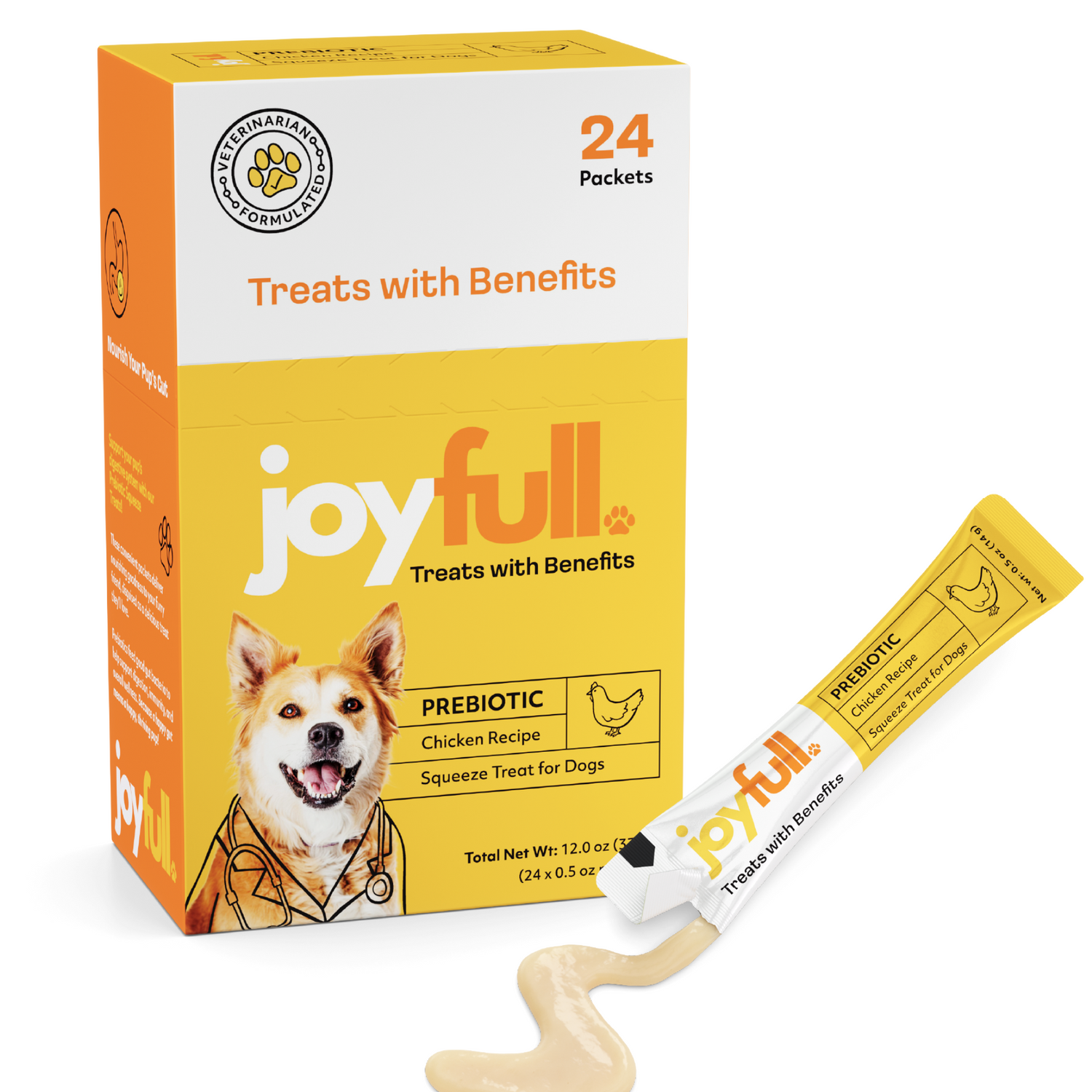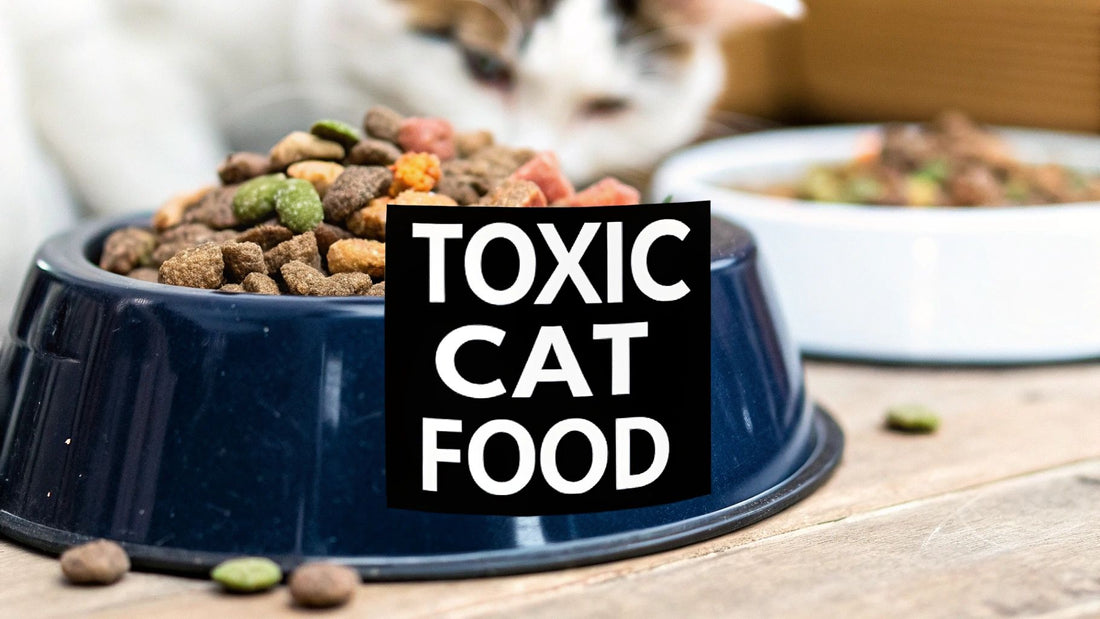
Top Ingredients to Avoid in Cat Food for a Healthy Pet
As a devoted cat parent, you strive to provide the absolute best for your feline companion. But navigating the complex world of cat food labels can feel like deciphering a foreign language. Confusing terms like 'by-products,' 'meal,' and various chemical names often mask the true quality of what’s inside the bag.
The unfortunate reality is that many commercial cat foods are packed with fillers, artificial additives, and low-grade ingredients that offer minimal nutritional value. Over time, these components can contribute to health issues ranging from digestive upset to more serious long-term conditions. Understanding what goes into your cat's bowl is the first step toward promoting their lifelong wellness.
This guide is designed to empower you with clear, straightforward information. We will break down eight of the most common and problematic ingredients to avoid in cat food, explaining precisely why they are harmful and how you can identify them on a label. By learning what to look for and what to leave on the shelf, you can confidently choose a diet that truly nourishes your cat, supporting their health and happiness for years to come. Let's dive into the specifics so you can make informed decisions for your pet.
1. By-Products and By-Product Meals (Generic)
When scanning a cat food label, the term "by-product" often raises a red flag, but it's the generic nature of this ingredient that's the real cause for concern. By-products are the non-rendered, clean parts of slaughtered animals, which can include nutrient-rich organs like lungs, spleen, and liver. The problem arises when the label is vague, listing ingredients like "meat by-products" or "poultry by-products" without specifying the source animal. This lack of transparency is a major issue when looking for high-quality ingredients to avoid in cat food.
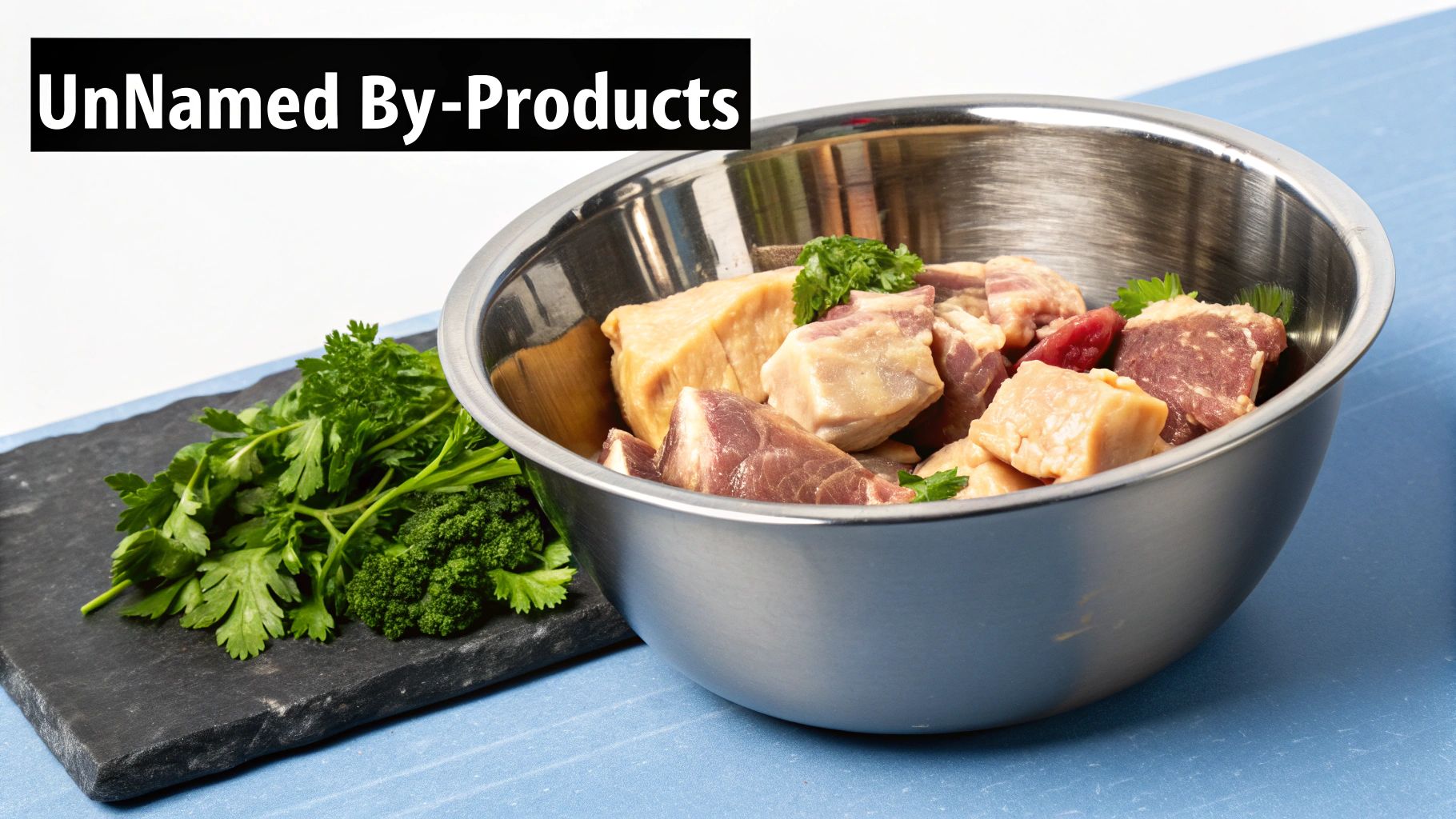
This ambiguity means the source could be any combination of animals, such as cattle, pigs, goats, or sheep, and the exact composition can vary significantly from one bag to the next. Such inconsistency makes it impossible to monitor your cat's diet, trace potential allergens, or ensure a steady nutritional profile. It suggests a lower-quality ingredient used by manufacturers to cut costs.
Why It's a Problem
Generic by-products are problematic for several key reasons:
- Lack of Quality Control: Without a named source, the quality of the protein is questionable. The nutritional value can fluctuate wildly between batches.
- Potential Allergens: If your cat has a food sensitivity or allergy to a specific protein like beef, a generic "meat by-product" ingredient could trigger a reaction without you ever knowing the cause.
- Inconsistent Nutrition: Cats thrive on consistency. A food that changes its protein sources batch-to-batch can lead to digestive upset and unpredictable nutrient intake.
How to Spot and Avoid Generic By-Products
To ensure your cat gets the best, be a vigilant label reader. Instead of grabbing the first bag you see, take a moment to analyze the ingredient list for these tell-tale signs of low-quality, generic fillers.
Actionable Tips:
- Look for Named Sources: Opt for foods that list specific by-products, such as "chicken by-products" or "turkey by-product meal." This indicates transparency and a consistent formula.
- Check Ingredient Ranking: Avoid any food where a generic by-product is listed as one of the first few ingredients. The primary protein source should always be a high-quality, named meat.
- Choose Transparent Brands: Reputable manufacturers are often proud of their ingredient sourcing and will provide detailed information on their websites or upon request.
2. Artificial Colors and Dyes
Have you ever noticed cat food kibble with vibrant red, green, or yellow pieces? These hues are not natural; they are the result of artificial colors and dyes. Ingredients like Red 40, Blue 2, and Yellow 6 are synthetic additives used by manufacturers for one reason only: to appeal to the human buying the food. Cats are largely colorblind and are drawn to food by scent and taste, making these dyes nutritionally pointless and purely cosmetic. Their presence is a significant red flag when searching for high-quality ingredients to avoid in cat food.
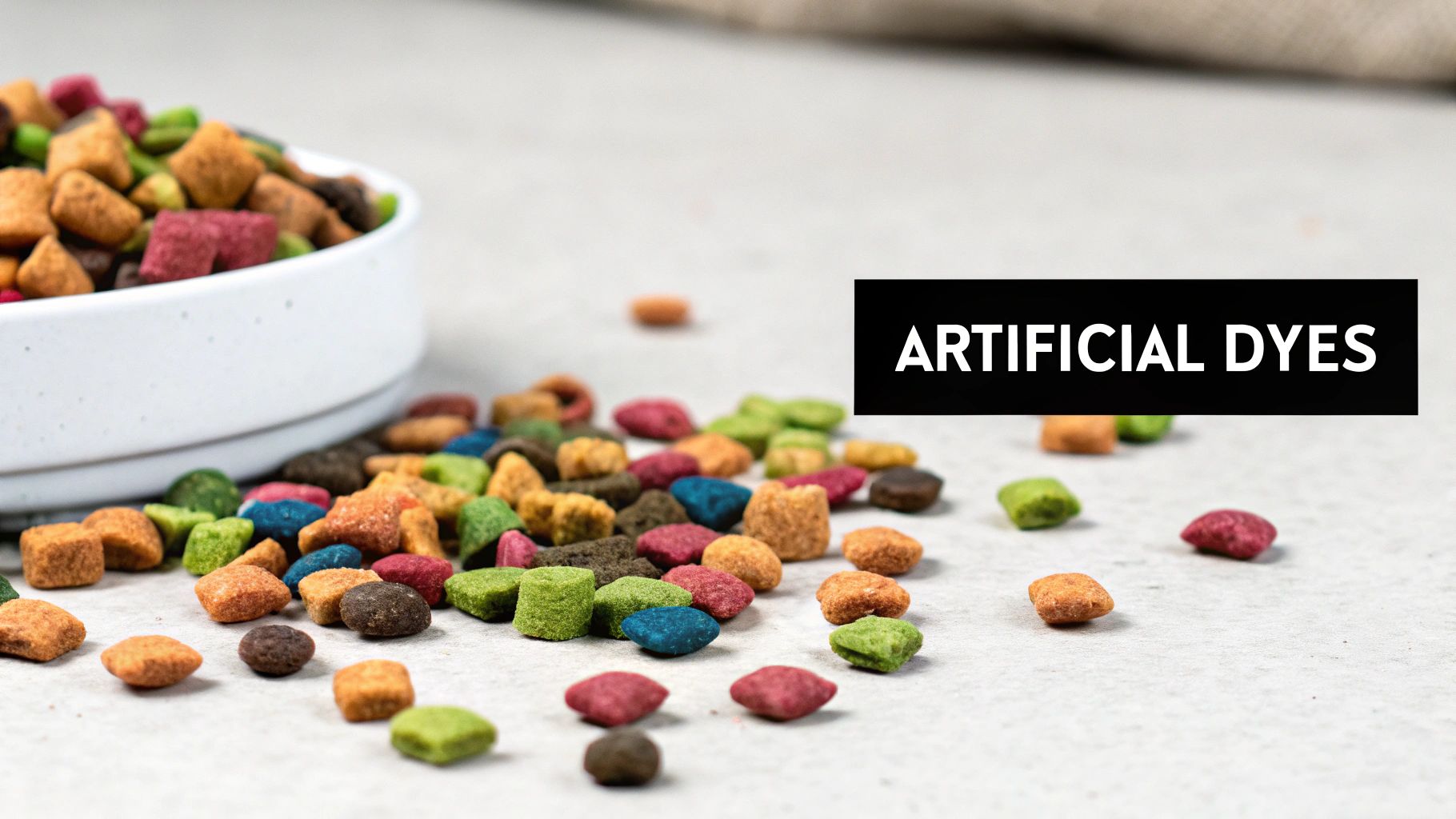
These chemical colorants offer zero nutritional value to your cat. Instead, they introduce unnecessary synthetic compounds into their diet. While approved for use, a growing body of research links these additives to potential health issues in sensitive pets, including allergic reactions and behavioral changes like hyperactivity. A food that relies on cosmetic appeal to sell itself is often compensating for lower-quality primary ingredients.
Why It's a Problem
Artificial colors and dyes are problematic for several key reasons:
- No Nutritional Benefit: They are purely for aesthetics and serve no purpose for your cat's health or well-being. A natural, uniform brown kibble is perfectly fine.
- Potential Health Risks: Synthetic dyes have been linked to allergic reactions, skin irritation, digestive upset, and behavioral problems in some cats.
- Marketing Gimmick: Their inclusion often signals a lower-quality food. Brands that prioritize nutrition don't need to add colorful gimmicks to attract customers.
How to Spot and Avoid Artificial Colors and Dyes
Becoming a savvy shopper means looking past the colorful marketing and focusing on the actual ingredient list. A high-quality cat food doesn't need to look like a bag of candy to be appealing and nutritious for your feline companion.
Actionable Tips:
- Read the Ingredient List: Scrutinize the label for terms like "FD&C Red No. 40," "Yellow 5," "Blue 2," or simply "color added." These are clear indicators of artificial dyes.
- Look for Natural Alternatives: Some high-quality brands use natural colorants like beet juice or turmeric if color is added, but most simply let the ingredients provide the natural color.
- Choose "No Artificial Colors" Formulas: Many reputable brands proudly state "no artificial colors, flavors, or preservatives" on their packaging. This is a good sign of a more natural product.
3. BHA, BHT, and Ethoxyquin
While scanning the ingredient list, you might overlook a few acronyms near the end, but BHA (butylated hydroxyanisole), BHT (butylated hydroxytoluene), and ethoxyquin are crucial ingredients to avoid in cat food. These are powerful, synthetic chemical preservatives used to prevent fats and oils from going rancid, dramatically extending the shelf life of dry kibble. Although effective for preservation, their use is highly controversial due to potential links to serious, long-term health problems in pets.
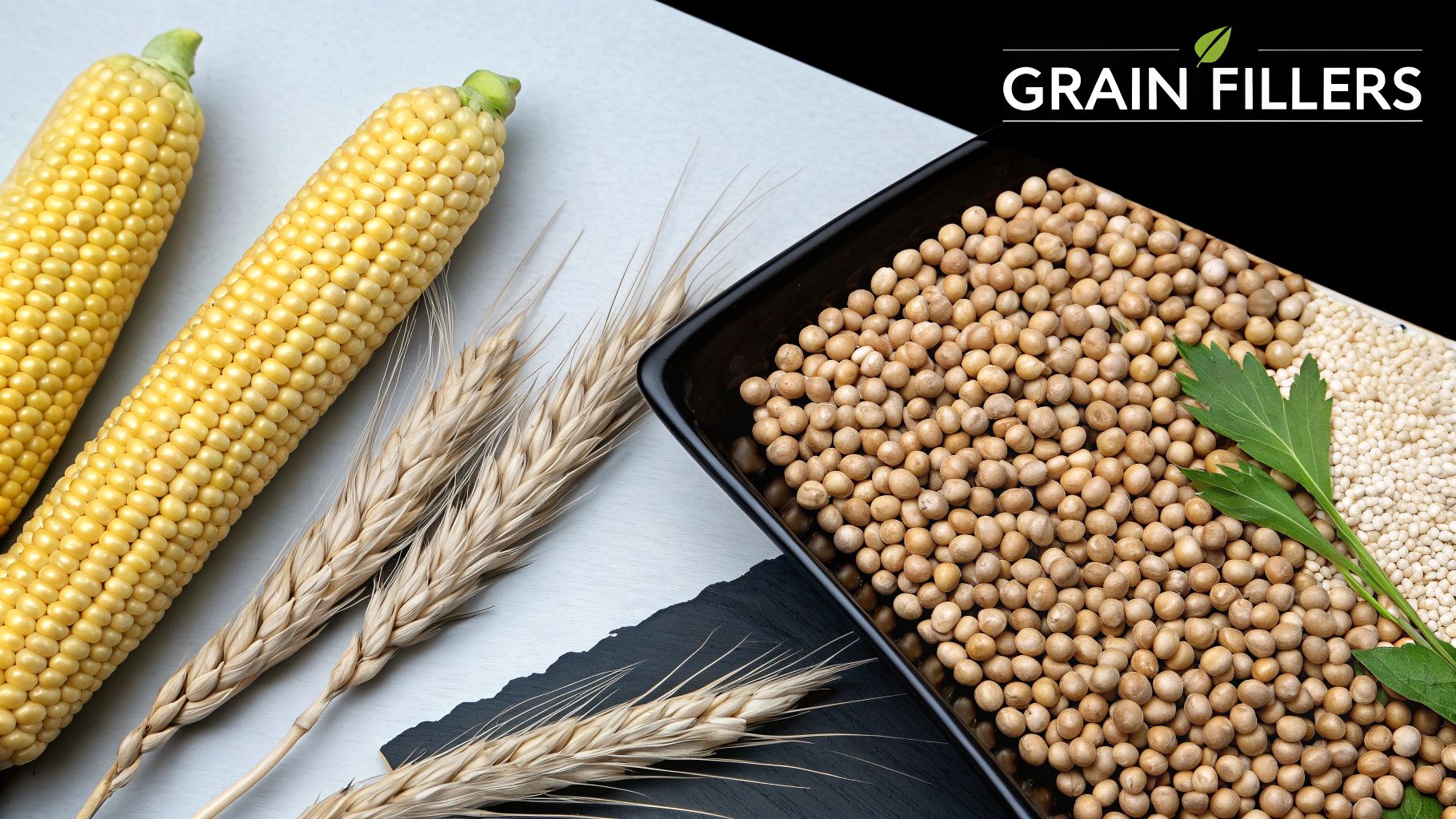
The primary concern is that these chemicals have been associated with a range of health issues, including liver and kidney damage, immune system dysfunction, and even cancer. Ethoxyquin is particularly alarming as it is also used industrially as a pesticide and a hardening agent for rubber. While manufacturers that use them claim the amounts are safe, many pet owners prefer to err on the side of caution and avoid feeding their cats chemicals with such questionable safety records, especially when effective natural alternatives exist.
Why It's a Problem
These artificial preservatives pose several significant risks to your cat's health:
- Potential Carcinogens: Both BHA and BHT have been identified as potential cancer-causing agents in animal studies, raising serious concerns about long-term exposure.
- Organ Damage: Research has linked the consumption of these chemicals to adverse effects on the liver, kidneys, and thyroid, which are vital for your cat's overall health and detoxification processes.
- Hidden in Ingredients: Ethoxyquin is often used to preserve fish meals before they even arrive at the pet food factory, meaning it may not be directly added by the manufacturer and thus might not appear on the final ingredient list.
How to Spot and Avoid BHA, BHT, and Ethoxyquin
Protecting your cat from these chemicals requires careful label inspection and choosing brands committed to natural preservation. A little extra diligence when shopping can make a big difference for your feline's well-being. To learn more, read about other harmful ingredients to avoid in cat food on joyfullpet.com.
Actionable Tips:
- Look for Natural Preservatives: Choose foods preserved with mixed tocopherols (a source of vitamin E), vitamin C (ascorbic acid), or plant extracts like rosemary oil.
- Choose "Preservative-Free" or "No Artificial Preservatives" Claims: Brands that avoid these chemicals will often state it clearly on their packaging.
- Buy Smaller Bags: Purchase bags of food you can use within a month. This reduces the need for strong chemical preservatives and ensures your cat is eating fresh kibble.
- Contact the Manufacturer: If you're unsure, especially about fish meal ingredients, contact the brand directly and ask if they test their raw ingredients for ethoxyquin.
4. Corn, Wheat, and Soy Fillers
While browsing the cat food aisle, you’ll find that corn, wheat, and soy are incredibly common ingredients, often used by manufacturers as inexpensive fillers and to boost the protein percentage on the label. However, cats are obligate carnivores, meaning their bodies are designed to derive nutrients primarily from animal-based protein. These plant-based ingredients offer very little nutritional value for felines and are often pinpointed as key ingredients to avoid in cat food.
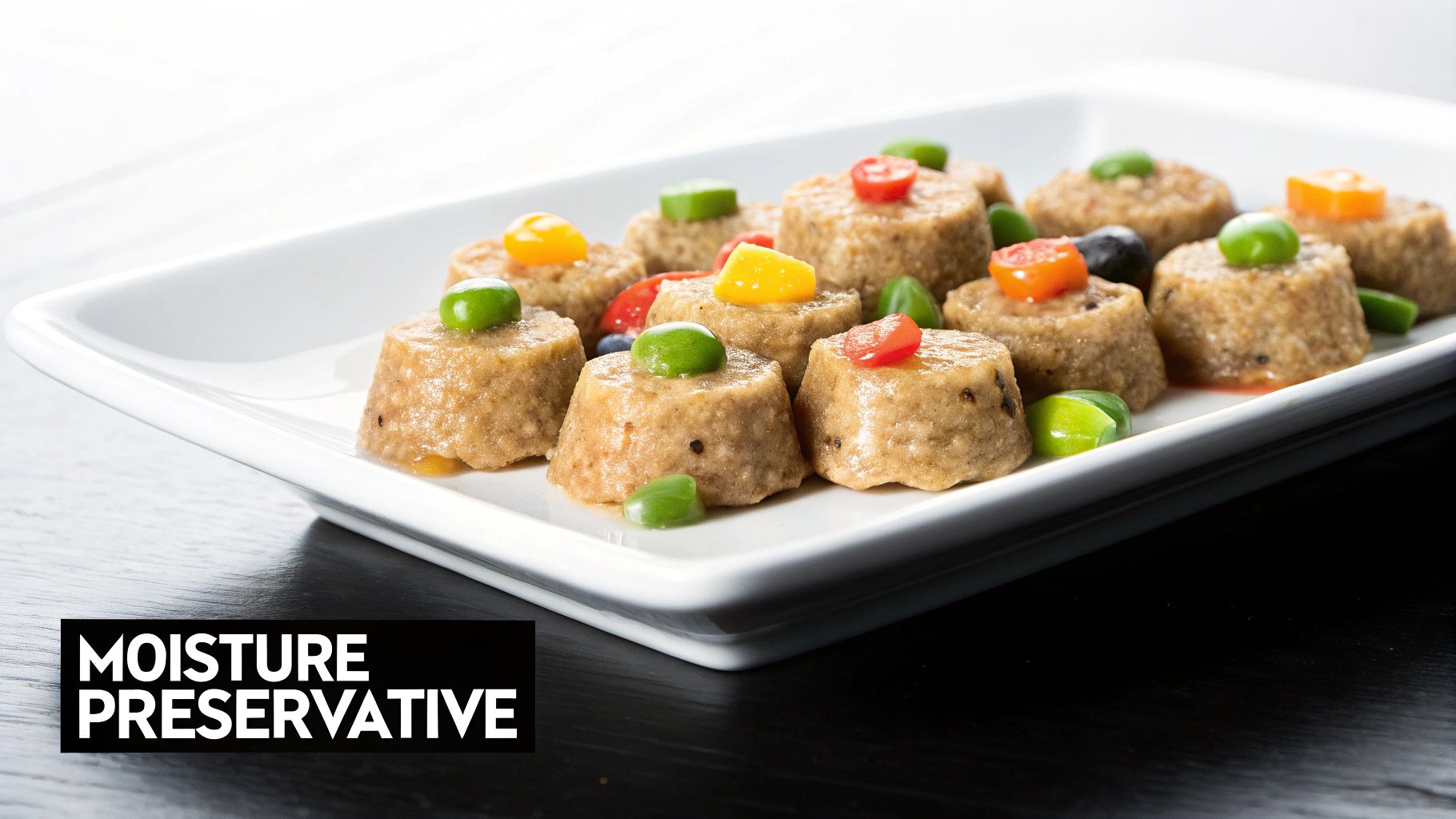
Ingredients like corn gluten meal, wheat flour, and soybean meal are difficult for cats to digest and can lead to gastrointestinal upset. More importantly, the protein they contain is "incomplete" for a cat, lacking the essential amino acids like taurine that felines must get from meat. Relying on these fillers can contribute to long-term health issues, including obesity, diabetes, and food allergies, making them a poor choice for your carnivorous companion.
Why It's a Problem
Using these grains and legumes as foundational ingredients in cat food is problematic for several reasons:
- Biologically Inappropriate: Cats have no dietary requirement for carbohydrates from grains. Their digestive systems are short and not equipped to efficiently break down and utilize plant matter.
- Poor-Quality Protein: Plant-based proteins lack the full spectrum of essential amino acids that cats require. A food high in corn gluten meal may look good on the protein analysis but fails to provide proper nourishment.
- Common Allergens: Wheat, corn, and soy are frequent culprits behind food sensitivities and allergies in cats, leading to symptoms like itchy skin, chronic ear infections, and digestive upset.
- High Glycemic Index: These ingredients can cause rapid spikes in blood sugar, contributing to weight gain and increasing the risk of feline diabetes.
How to Spot and Avoid These Fillers
Identifying and avoiding these low-quality carbohydrates is a crucial step in providing a species-appropriate diet. Diligent label reading is your best tool for ensuring your cat's food is meat-based and nutritious.
Actionable Tips:
- Check the First Five Ingredients: Always ensure a high-quality, named animal protein (like deboned chicken or salmon) is the very first ingredient. Avoid any food where corn, wheat, or soy appears near the top of the list.
- Opt for Grain-Free (When Appropriate): Choosing a grain-free formula is often the simplest way to eliminate these problematic fillers. However, ensure the food isn't just swapping them for other high-carbohydrate fillers like potatoes or peas. To understand the nuances of selecting the best diet, you can learn more about how to choose cat food on joyfullpet.com.
- Monitor for Sensitivities: If your cat exhibits symptoms like excessive scratching, vomiting, or diarrhea, their food could be the cause. Consider an elimination diet under your vet’s guidance to pinpoint a potential grain or soy allergy.
- Read Past the Marketing: Ignore flashy claims like "veterinarian recommended" or "natural" on the front of the bag. The ingredient list is the only source of truth.
5. Propylene Glycol
Propylene glycol is a synthetic chemical commonly used as a humectant, which means it helps retain moisture and maintain a soft, chewy texture in semi-moist pet foods and treats. While the FDA considers it generally safe for human and canine consumption in small amounts, it is a particularly dangerous ingredient to avoid in cat food. Cats have a unique physiology, and their red blood cells are highly susceptible to oxidative damage from this compound.
The primary danger for felines is that propylene glycol can cause a serious condition known as Heinz body anemia. This occurs when the chemical damages hemoglobin within red blood cells, leading to their premature destruction. Even small, regular amounts found in soft-baked treats or semi-moist food pouches can accumulate and lead to lethargy, weakness, and other severe health complications. Its presence is a clear indicator of a product not formulated with feline safety as a top priority.
Why It's a Problem
Propylene glycol is a significant risk to feline health for these key reasons:
- Causes Heinz Body Anemia: It directly damages a cat's red blood cells, impairing their ability to carry oxygen throughout the body. This can lead to serious and potentially life-threatening anemia.
- Unnecessary Additive: Its sole purpose is to improve texture and shelf life in semi-moist foods. Healthier, safer alternatives like freeze-dried or dehydrated treats offer better nutritional value without this risk.
- Indicates Low-Quality Formulation: The use of propylene glycol often points to a focus on product texture and cost-effectiveness over the biological needs and safety of cats.
How to Spot and Avoid Propylene Glycol
Protecting your cat from this harmful additive requires careful examination of ingredient labels, especially for any soft or chewy products. Never assume a product marketed for cats is automatically safe.
Actionable Tips:
- Scrutinize Semi-Moist Products: Pay extra close attention to the ingredient lists on semi-moist cat foods, soft-baked treats, and food pouches, as these are the most common culprits.
- Choose Safer Alternatives: Opt for freeze-dried, dehydrated, or traditionally baked crunchy treats. These do not require chemical humectants to maintain their form and are generally healthier.
- Look for Natural Humectants: If a softer texture is desired, look for products that use natural, cat-safe humectants like vegetable glycerin instead of propylene glycol.
- Avoid It Completely: If "propylene glycol" is on the label of any food or treat, do not purchase it for your cat. The risk far outweighs any perceived benefit.
6. Sugar and Sweeteners
Finding sugar, corn syrup, or other sweeteners on a cat food label is a significant red flag for any discerning pet owner. Unlike humans, cats lack the taste receptors for sweetness, meaning these additives provide no flavor enhancement for them. Their inclusion is purely for the benefit of marketing to humans or as a cheap binder, offering zero nutritional value to an obligate carnivore. These unnecessary carbohydrates are one of the most problematic ingredients to avoid in cat food.
Added sugars contribute empty calories that can lead to a host of serious health issues over time. While a small amount might not seem harmful, consistent consumption can contribute to weight gain, which puts cats at risk for diabetes, joint problems, and other obesity-related conditions. Furthermore, artificial sweeteners like xylitol, often found in human "sugar-free" products, are extremely toxic to pets and can be fatal even in small doses.
Why It's a Problem
Sugars and sweeteners pose several risks to your cat's health:
- Risk of Obesity and Diabetes: Unnecessary calories from sugar can easily lead to weight gain, a primary risk factor for developing feline diabetes.
- Dental Issues: Just like in humans, sugar can contribute to dental decay, plaque buildup, and painful gum disease, which can be costly and difficult to treat.
- No Nutritional Value: Cats have no biological requirement for carbohydrates like sugar. These ingredients displace more species-appropriate, nutrient-dense components like animal protein and fat.
- Toxicity Risk: Artificial sweeteners, particularly xylitol, are highly poisonous to cats and can cause a rapid drop in blood sugar, seizures, and liver failure.
How to Spot and Avoid Sugar and Sweeteners
Protecting your cat from these harmful additives requires careful examination of ingredient labels on both food and treats. Sugars can be disguised under many different names, so diligence is key.
Actionable Tips:
- Read All Labels Carefully: Scrutinize the ingredient list for terms like sugar, corn syrup, fructose, molasses, or sucrose. They are often found in semi-moist foods and treats.
- Avoid Xylitol Completely: Never give your cat any human food, especially "sugar-free" products like gum, candy, or some peanut butters, as they may contain xylitol. Check all labels before sharing anything.
- Choose Meat-Based Treats: Opt for single-ingredient or limited-ingredient treats made from meat, poultry, or fish. These provide nutritional value without the harmful additives.
- Question "Palatability Enhancers": Be wary of foods that use sugar to make a low-quality formula more appealing. A high-quality food relies on the natural flavor of its meat ingredients.
7. Excessive Plant Proteins and Vegetable Proteins
While high protein content on a cat food label might seem desirable, the source of that protein is critically important. Ingredients like pea protein, potato protein, and other concentrated plant proteins are often used by manufacturers to artificially inflate the "crude protein" percentage on the guaranteed analysis. This practice is a cost-cutting measure, as these vegetable proteins are significantly cheaper than high-quality animal-based proteins. However, this is one of the key ingredients to avoid in cat food because it fails to meet a cat's biological needs.
Cats are obligate carnivores, meaning their bodies are designed to derive essential nutrients almost exclusively from meat. Plant proteins lack the complete amino acid profile that cats require, particularly taurine and arginine, which are vital for heart health, vision, and metabolic function. While a food's protein percentage may look high on paper, if it's propped up by plant sources, your cat may not be able to properly absorb and utilize it, potentially leading to nutritional deficiencies.
Why It's a Problem
Using excessive plant proteins to formulate cat food is problematic for several reasons:
- Poor Bioavailability: Cats cannot digest and absorb nutrients from plant matter as efficiently as they can from animal tissue. Much of the protein passes through their system unused.
- Incomplete Amino Acid Profile: Plant proteins are deficient in the specific amino acids that are essential for a cat's health, which can only be found in sufficient quantities in animal sources.
- Misleading Labels: A high "crude protein" value can give pet owners a false sense of security, masking the low quality of the actual protein sources used in the formula.
How to Spot and Avoid Excessive Plant Proteins
Becoming a savvy label inspector is the best way to ensure your cat's diet is biologically appropriate. Don't be swayed by marketing claims of "high protein"; instead, focus on where that protein comes from.
Actionable Tips:
- Prioritize Animal Proteins: Ensure that named meat sources like "deboned chicken," "turkey meal," or "salmon" are the first ingredients. Plant proteins like "pea protein" should never appear in the top five.
- Scrutinize "Grain-Free" Formulas: Many grain-free foods replace grains with high levels of legumes and potatoes, which introduces excessive plant protein. Check the full ingredient list, not just the front of the bag.
- Understand Protein Quality vs. Quantity: Focus on the quality of ingredients over a single percentage. To understand more about what constitutes truly high-quality protein for your feline, you can learn more about cat food with high protein on joyfullpet.com.
8. Rendered Fat from Unknown Sources
Just as with protein, the source of fat in your cat's food is a crucial indicator of its overall quality. When you see a vague term like "animal fat" on an ingredient list, it should give you pause. This generic ingredient is rendered fat, a product created by heating animal tissues to separate the fat. The concern isn't the rendering process itself, but the complete lack of transparency about the source animal. This is a significant red flag when identifying ingredients to avoid in cat food.
This ambiguity means the fat could be sourced from a mix of animals, including those that were diseased, disabled, or died from causes other than slaughter. The quality and nutritional profile of this fat can vary dramatically from batch to batch, and it may be preserved with synthetic chemicals like BHA or BHT to prevent it from going rancid. High-quality fats are essential for a cat's skin, coat, and overall health, making a specified source non-negotiable.
Why It's a Problem
Generic rendered fat poses several risks to your cat's well-being:
- Questionable Quality: The "4-D" animals (dead, dying, diseased, or disabled) can legally be used in rendered animal fat, introducing potential toxins and contaminants.
- Harmful Preservatives: Unspecified fats are often stabilized with synthetic preservatives like BHA and BHT, which are controversial and linked to health issues in some studies.
- Inconsistent Nutrition: The fatty acid profile can change between bags, leading to unpredictable effects on your cat's skin, coat, and energy levels. It also makes it impossible to identify allergens.
How to Spot and Avoid Generic Rendered Fat
To protect your cat from low-quality fats, you must become an expert at deciphering the ingredient panel. Paying close attention to how fats are listed can make all the difference in the nutritional value of their food.
Actionable Tips:
- Look for Named Fat Sources: Always choose foods that specify the source of the fat, such as "chicken fat," "salmon oil," or "pork fat." This transparency is a hallmark of a quality manufacturer.
- Check the Preservative: Opt for fats preserved with natural antioxidants like mixed tocopherols (a source of Vitamin E), rosemary extract, or citric acid instead of BHA, BHT, or ethoxyquin.
- Prioritize Omega Fatty Acids: High-quality foods often use fish oils like salmon or pollock oil, which are excellent sources of beneficial omega-3 fatty acids for your cat's health.
Key Ingredients to Avoid in Cat Food: Top 8 Comparison
| Item | Implementation Complexity 🔄 | Resource Requirements ⚡ | Expected Outcomes 📊 | Ideal Use Cases 💡 | Key Advantages ⭐ |
|---|---|---|---|---|---|
| By-Products and By-Product Meals | Low complexity; often generic 🔄 | Low cost; variable ingredient quality ⚡ | Variable nutrition; inconsistent quality 📊 | Budget pet foods; filler protein source 💡 | Cost-effective protein filler ⭐ |
| Artificial Colors and Dyes | Simple addition; low process 🔄 | Minimal resources; synthetic chemicals ⚡ | No nutritional benefit; potential health risks 📊 | Foods aimed at human appeal only 💡 | Enhances visual appeal for owners ⭐ |
| BHA, BHT, and Ethoxyquin | Moderate; chemical preservation 🔄 | Cost-effective synthetic preservatives ⚡ | Long shelf life; health concerns 📊 | Extending shelf life in dry kibbles 💡 | Highly effective preservation ⭐ |
| Corn, Wheat, and Soy Fillers | Low complexity; widely available 🔄 | Low cost plant-based ingredients ⚡ | Poor protein quality; allergenic potential 📊 | Low-budget pet foods; protein filler 💡 | Inexpensive protein/carbohydrate source ⭐ |
| Propylene Glycol | Moderate; moisture retention 🔄 | Synthetic chemical additive ⚡ | Moisture preservation; toxic to cats 📊 | Semi-moist foods and treats 💡 | Maintains texture and moisture ⭐ |
| Sugar and Sweeteners | Very low complexity 🔄 | Cheap; various forms ⚡ | No feline benefit; obesity and toxicity risk 📊 | Human-appealing treats; palatability boosters 💡 | Improves taste for humans ⭐ |
| Excessive Plant and Vegetable Proteins | Moderate; protein boosting 🔄 | Cost-effective plant proteins ⚡ | Incomplete amino acids; poor digestibility 📊 | Grain-free or budget formulas 💡 | Artificially boosts protein content ⭐ |
| Rendered Fat from Unknown Sources | Low complexity; variable origin 🔄 | Low cost; questionable sources ⚡ | Variable quality; potential toxins 📊 | Low-cost fat inclusion in pet food 💡 | Cost-efficient fat source ⭐ |
Choosing a Joyfull Diet for Your Cat's Wellness
Navigating the world of pet food labels can often feel like a daunting task, filled with confusing terms and hidden pitfalls. However, by understanding which ingredients to avoid in cat food, you are now equipped with the knowledge to make informed, confident decisions that directly contribute to your feline friend's long-term health and vitality. This isn't just about avoiding the bad; it's about actively choosing the good.
The journey to better feline nutrition begins with a simple commitment to reading and understanding the ingredient panel. By sidestepping the eight problematic ingredients we've discussed, from vague by-products and chemical preservatives like BHA and BHT to unnecessary grain fillers and artificial additives, you are taking a powerful stand for your pet's well-being. You are choosing a path that prioritizes clean, species-appropriate nutrition over cost-cutting fillers and synthetic enhancements.
Your Action Plan for Better Feline Nutrition
Moving forward, the goal is to transform this knowledge into action. Here are your next steps:
- Audit Your Pantry: Take a look at your current cat food. Compare its ingredient list against the items we've covered. Don't feel discouraged if you find some of them; simply use this as your starting point for making a change.
- Prioritize Animal Protein: Remember that cats are obligate carnivores. The very first ingredients on the label should be named animal proteins, such as "chicken," "turkey," or "salmon," not generic "meat" or plant-based proteins.
- Question Vague Terms: Be a skeptical shopper. If you see terms like "animal fat" or "meat and bone meal" without a specified source, it’s a red flag. Transparency is key to quality.
- Transition Slowly: When you decide to switch to a higher-quality food, do it gradually over 7-10 days. Mix a small amount of the new food with the old, slowly increasing the ratio to prevent digestive upset.
Mastering the art of label reading is one of the most significant gifts you can give your cat. It empowers you to look past the flashy marketing on the front of the bag and focus on the nutritional substance within. This simple skill translates directly into a healthier coat, better digestion, more stable energy levels, and a stronger immune system for your companion. By avoiding harmful ingredients, you are not just feeding your cat; you are actively investing in their future health, happiness, and the precious years you will share together.
Ready to skip the label-reading stress and serve your cat a meal you can feel great about? At Joyfull, we've done the hard work for you. Our recipes are veterinarian-advised and formulated without any of the harmful fillers, artificial additives, or vague by-products discussed in this article, ensuring your cat gets the pure, high-quality nutrition they deserve. Explore our clean, carnivore-focused formulas at Joyfull and make mealtime a truly joyful experience.
